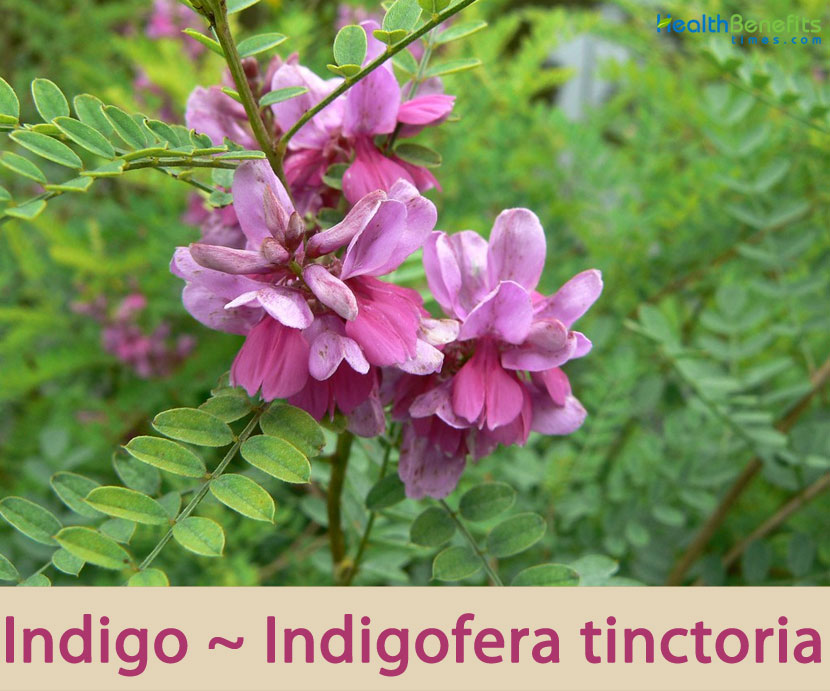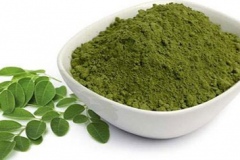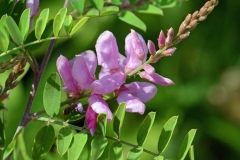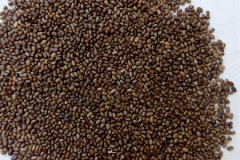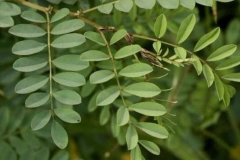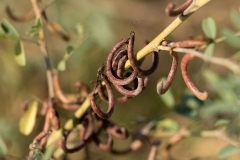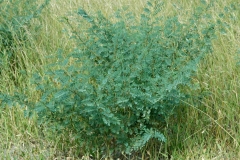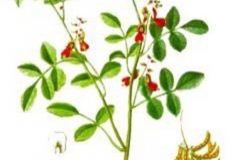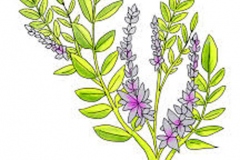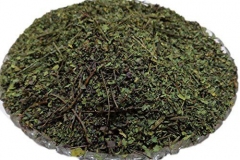Today most dye is synthetic, but natural dye from I. tinctoria is still available, marketed as natural coloring where it is known as tarum in Indonesia and nila in Malaysia. In Iran and areas of the former Soviet Union it is known as basma. The plant is also widely grown as a soil-improving groundcover. Its leaves when dried in shade turn blue in color. It has been used for centuries to obtain blue dye used in coloring clothes. It is much less in demand today for commercial dye purposes because of the creation of synthetic dyes which have now taken its place for most purposes. Plants are still commercially grown, mostly on small farms, for those desiring natural dye, premium clothing companies, amateur gardeners, and traditional medicine.
Indigo Facts
| Indigo Quick Facts | |
|---|---|
| Name: | Indigo |
| Scientific Name: | Indigofera tinctoria |
| Origin | Tropical and temperate Asia, as well as parts of Africa, |
| Colors | Green when young turning to brown as they mature |
| Shapes | Linear pod 20–35 mm long and c. 2 mm wide and thick, straight or slightly curved, rounded in cross-section |
| Taste | Bitter, Acrid |
| Health benefits | Glowing Skin, Sores, Ringworm Blisters, Hair rejuvenation, Removing Worms in Teeth and Gums, Sores on skin, Liver, Urinary problems and poison, Mouth Ulcers, Kidney Disease, Prevent Hair fall, For Insects in Ear, For Dog bite, Prevents dandruff and other scalp infections, Hair growth |
| Name | Indigo |
|---|---|
| Scientific Name | Indigofera tinctoria |
| Native | Naturalized to tropical and temperate Asia, as well as parts of Africa, but its native habitat is unknown since it has been in cultivation worldwide for many centuries |
| Common Names | Black henna, Commercial indigo, Common indigo, Dyer’s indigo, East Asian indigo plant, Frank indigo, Indian indigo, Indian maddar, Indigo, True indigo, Bengal Indigo, Ceylon Indigo, Madras Indigo, Wild Indigo, Dye indigo |
| Name in Other Languages | Albanian: llullaq Afrikaans: Indigo Amharic: Inigogo (ኢንጎጎ) Arabic: Allawn alnayliu (اللون النيلي), El badara, nylt zurqa (نيلة زرقاء) Armenian: Indigo Assamese: Neel (নীল) Azerbaijani: Indigo, Boyaq indiqoferası Bambara: Gala, Gara, Gara missé, Ngala Basque: Indigo, Anil Belarusian: Indyha (індыга) Bengali: Bēguni nīlabarṇa (বেগনি নীলবর্ণ), নীল (Nil) Bosnian: Indigo Brazil: Anil Bulgarian: Indigo (индиго) Catalan: Anyil Cebuano: Tagom Chichewa: Enaake Chinese: Diànqīng (靛青), Mu lan (木蓝) Corsican: Indigo Croatian: Indigo Cuba: Añil, añil cimarrón, añil de Guatemala Czech: Indigo, indigovník pravý Danish: Indigo, Indigoplanten Dutch: Indigo, Indigoboom, Indigogewassen English: Black henna, Commercial indigo, Common indigo, Dyer’s indigo, East Asian indigo plant, Frank indigo, Indian indigo, Indian maddar, Indigo, True indigo, Bengal Indigo, Ceylon Indigo, Madras Indigo, Wild Indigo, Dye indigo Esperanto: Indigo Estonian: Indigo Filipino: Indigo Finnish: Indigo, Väri-indigo French: Indigo, Indigo des teinturiers, Indigotier, Indigo des Indes, Indigotier, Indigo Sauvage Frisian: Indigo Galician: Indigo, Anil Georgian: Indigo German: Indigo, Indigopflanze, Indigostrauch, Faerber- Indigostrauch, Färberindigostrauch Greek: Indikó (ινδικό) Gujarati: Gali (ગળી), Gari, Nil Haitian Creole: Digo, digo digot Hawaiian: Indigo Hausa: Indigo, Báábáá, báábán kóóre, báábán rínii Hebrew: אִינדִיגוֹ, ניל הצבעים Hindi: Neel (नील), Neeli, neelini, nilika (नीलिका) Hmong: Indigo Hungarian: Indigó Icelandic: Indigo Igbo: Indigo Indonesian: Nila, Tarum Irish: Indigo Italian: Indaco, Anile, Indigofera, Pianta Dell’ Indaco, indaco domestic Japanese: Injigo (インジゴ), Nanbanai (ナンバンアイ), Taiwan komatsuna gi (タイワンコマツナギ) Javanese: Indigo, Tarum Kachchhi: Garijo jhada (ગરીજો ઝાડ), gudi (ગુડી), neel (નીલ) Kannada: Iṇḍiyā (ಇಂಡಿಗೋ), anjoora neeli (ಅಂಜೂರ ನೀಲಿ), hennu neeli (ಹೆಣ್ಣು ನೀಲಿ), neeli gida (ನೀಲಿ ಗಿಡ), olleneeli (ಒಳ್ಳೇ ನೀಲಿ) Kazakh: Indigo (Индиго ) Khmer: Indigo Kinyarwanda: Indigo Konkani: Neeli (नीळी) Korean: Nambich (남빛) Kurdish: Indigo Kyrgyz: Indigo (индиго) Ladakhi: Ni la (ནི་ལ་) Lao: Indigo Latin: Indicum illum saturatiorem Latvian: Indigo Lesser Antilles: French indigo Lithuanian: Indigas, Dažinė indigažolė Luxembourgish: Indigo Macedonian: Indigo (индиго) Malagasy: Indigo Malay: Indigo, Tarum, Tom, Pokok Tarum Malayalam: inḍigēā (ഇൻഡിഗോ), nīlayamari (നീലയമരി), amari (അമരി), nilayamari (നീലയമരി) Maltese: Indigo Manipuri: ꯅꯤꯝ nim Maori: Poropango Marathi: neel (नीळ), nili (नीली) Mizo: Chi-cha Mongolian: Indigo Myanmar (Burmese): Mell naal (မဲနယ်), me-nai, me-net Nepali: Neel (नील) Norwegian: Indigo Occitan: Indigòt Odia: ଇଣ୍ଡିଗୋ |, ନୀଳ nila, ରଙ୍ଗପୁଷ୍ପ rangapushpa, ଶ୍ଯାମଳିକା shyamalika Pali: Nili (नीली) Pashto: انډيگو Persian: نیلی, درخت نیل Polish: Indigo, Indygowiec barwierski, Indygo, indygowiec farbiarski Portuguese: Anileiro, Indigo, Indigoteiro, Indigueiro, andeira, anileira-da-índia, anileira-verdadeira, anil Puerto Rico: Añil verdadero Punjabi: Nila (ਨੀਲ) Rajasthani: Neel (नील) Romanian: Indigo, Planta de indigo Russian: Indigo (индиго), Indigofera Krasilnaya (Индигофера красильная) Samoan: Indigo Sanskrit: Nilla, Nili, Nilika, Rangapatri, neelika, nilapushpa, gandhapushpa (गन्धपुष्पा), maharasa (महारसा), nilaka (नीलक), nilini (नीलिणी), rangapushpi (रङ्गपुष्पी), ranjani (रञ्जनी), shyamalika (श्यामलिका) Scots Gaelic: Indigo Serbian:Indigo (индиго) Sesotho: Indigo Shona: Indigo Sindhi: انڊگو Sinhala: Inḍigō (ඉන්ඩිගෝ), Nil-awari (නිල් අවරිය) Slovak: Indigo Slovenian: Indigo Somali: Indigo Spanish: Indigo, Añil, Añilera, Ruda cimarrona Sudanese: Indigo, Tarum Swahili: Indigo Swedish: Indigo Tagalog: Malatayum Tajik: Indigo (Индиго) Tamil: Iṇṭikō (இண்டிகோ), Avuri (அவுரி), Neela amari, Neela avari, Nila amari, Nili, nili (நீலி) Tatar: Indigo (индиго) Telugu: Iṇḍigō (ఇండిగో) , aviri (అవిరి), nilichettu (నీలిచెట్టు) Tibetan: Ni la(ནི་ལ་) Thai: Khrām (คราม) Tulu: Neeli (ನೀಲಿ) Turkish: Civit, İndigo ağacı Turkmen: Indigo Ukrainian: Indyho (індиго) Urdu: Neel (نيل), nilika (نيلکا) Uyghur: Indigo Uzbek: Indigo Vietnamese: Chàm, Chàm đậu, Chàm quả cong Welsh: Indigo Xhosa: Indigo Yiddish: Indigo (ינדיגאָ) Yoruba: indigo, Elú-àjà , Elú-weere , Sense Zulu: Indigo |
| Plant Growth Habit | Erect, copiously-branched, deciduous spreading tropical herb or small bushy perennial shrub |
| Growing Climates | Brushwood, bush margins, grassy fields, and secondary forest, seasonally flooded grassy fields and sandy coasts and along roadsides and riverbanks, around villages, roadsides, disturbed areas, and grassland |
| Plant Size | 1-2 m upon maturity |
| Stem | Cylindrical, full, erect, more less woody at the base, abundantly branched, the young parts and the twigs are covered with bifid, appressed, whitish hairs |
| Leaf | Compound imparipinnate and alternate. They comprise of 9 to 13 leaflets. At the base of the petiole, the stipules are narrowly triangular, 1.5 to 3 mm long |
| Flower | Small, about 5 mm long, bisexual, papilionaceae type, with pedicel 1 to 1.5 mm long |
| Fruit Shape & Size | Linear pod 20–35 mm long and c. 2 mm wide and thick, straight or slightly curved, rounded in cross-section |
| Fruit Color | Green when young turning to brown as they mature |
| Seed | Shortly oblong, about 2 mm long and 1.5 mm wide, rhombic in cross section |
| Taste | Bitter, Acrid |
| Plant Parts Used | Whole plant, dried leaf, root, fruit dye |
| Health Benefits |
|
| Culinary Uses |
|
| Precautions |
|
Plant Description
Indigo is an erect, copiously-branched, deciduous spreading, tropical herb or small bushy perennial shrub that normally grows about 1-2 m upon maturity. The spreading or ascending branches become more or less woody and can persist for more than a year. The stem is cylindrical, full, erect, and less woody at the base, abundantly branched, the young parts and the twigs are covered with a white pubescence, consisting of bifid, appressed, hairs. The plant is found growing in brushwood, bush margins, grassy fields, and secondary forest, seasonally flooded grassy fields and sandy coasts and along roadsides and riverbanks, around villages, roadsides, disturbed areas and grassland.
Leaves
Leaves are compound imparipinnate and alternate. They comprise of 9 to 13 leaflets. At the base of the petiole, the stipules are narrowly triangular, 1.5 to 3 mm long. The leaflets are opposite, obovate to elliptic, 5 to 23 mm long and 3 to 12 mm wide, with sparse navicular hairs on the underside. The upper side is glabrous. The apex is rounded and mucronate, the base is wedged or rounded. The margin is entire. Petiole and rachis are up to 7 cm long; they are covered with appressed hairs and sagging with a groove on the upper side.
Flower
The inflorescences are sessile axillary racemes, 3 to 6 cm, with numerous flowers. The bracts are narrowly triangular, about 1 mm long, more or less persistent. The flowers are small, about 5 mm long, bisexual, papilionaceae type, with pedicel 1 to 1.5 mm long. Calyx is 1.5 mm long, fused into a slanting cut at the base and the upper half divided into 5 triangular lobes, with white appressed hairs. Corolla is about 4 mm long, formed from an oval standard of about 4 mm long and 3.5 mm wide, whitish pink with reddish veins, two wings with very short claw, pink, and a keel with ‘lateral spurs, pink to red. Flower also consists of 10 stamens, 4 to 5 mm long, the free upper stamen, the other 9 fused together around the ovary. Superior Ovary is pubescent, with single carpel, surmounted by a long style.
Fruits
Fertile flowers are followed by linear seed pods, 20 to 35 mm long and 2 mm wide. They are straight or slightly curved towards the apex, brown when ripe, indehiscent, containing 7-12 seeds, with a slight constriction between seeds. The seeds are shortly oblong, about 2 mm long and 1.5 mm wide, rhombic in cross section.
History
The name indigo comes from the Roman term indicum, which means a product of India. This is rather of a misnomer since the plant is grown in many areas of the world, including Asia, Java, Japan, and Central America. Another ancient term for the dye is nil from which the Arabic term for blue, al-nil, is derived. The English word aniline comes from the same source.
The dye can be extracted from several plants, but historically the indigo plant was the most commonly used because it was more widely available. It belongs to the legume family and over three hundred species have been recognized. Indigo tinctoria and I. suifruticosa are the most common. In ancient times, indigo was a precious commodity because plant leaves consists of only about small amount of the dye (about 2-4%). Therefore, a large number of plants are required to produce a significant quantity of dye. Indigo plantations were founded in many parts of the world to ensure a controlled supply.
Demand for indigo dramatically increased during the industrial revolution, in part due to the popularity of Levi Strauss’s blue denim jeans. The natural extraction process was expensive and could not produce the mass quantities required for the burgeoning garment industry. So chemists began searching for synthetic methods of producing the dye. In 1883 Adolf von Baeyer (of Baeyer aspirin fame) researched indigo’s chemical structure. He found that he could treat omega-bromoacetanilide with an alkali (a substance that is high in pH) to produce oxindole. Later, based on this observation, K. Heumann identified a synthesis pathway to produce indigo. Within 14 years their work resulted in the first commercial production of the synthetic dye. In 1905 Baeyer was awarded the Nobel Prize for his discovery.
At the end of the 1990s, the German based company BASF AG was the world’s leading producer, accounting for nearly 50% of all indigo dyestuffs sold. In recent years, the synthetic process used to produce indigo has come under scrutiny because of the harsh chemicals involved. New, more environmentally responsible methods are being sought by manufacturers.
Health benefits of Indigo
Listed below are some of the popular health benefits of using Indigo
1. For Glowing Skin
Take some Indigo leaves and mash them and put them in boiling water. Extract the boiled leaves and apply on any part of the skin. Massage it on to the skin for some time to get glowing skin. Also small spots and boils on the skin will disappear.
2. For Sores, Ringworm Blisters
Get some Indigo leaves, dry them and powder them. Mix this powder with some sesame oil and apply on infected area. It will cure sores, ring worm and blisters.
3. For Hair rejuvenation
Get some Indigo leaves, dry them and powder them. Mix this powder with some sesame oil and apply on scalp. Soon hair will grow strong and healthy.
4. Removing Worms in Teeth and Gums
Get Indigo leaves and crush them to a juice. Add cinnamon stick oil on it. Dip a cotton ball in this oily juice and put beneath the infected tooth to get rid of worms. Do this at least 3 times.
5. For Sores on skin
Crush Indigo plant roots into a paste. Apply this on the sores that are secreting puss. Doing this regularly will cure painful sores.
6. Good for Liver
Take some Indigo leaves, dry them powder them. Add some honey to it and eat. Depending on age eat 1 gram to 3 grams every day for 1 month. This will cure sores and blisters on the liver and revitalize it.
7. For Urinary problems and poison
Get some Indigo leaves or roots and crush them. Boil them in hot water and filter it. Drink this decoction lukewarm. This will get rid of all urinary tract problems. It also works as an antidote to most poisons. Consume very little of this decoction based on age and constitution.
8. Cure Mouth Ulcers
Mouth ulcers are painful lesions that develop in the mouth or at the base of the gums. They are red in color and extremely painful, making eating and chewing food difficult. Crush some Indigo leaves and mix some honey in it. Apply this as an ointment to cure mouth ulcers.
9. Kidney Disease
Pluck out the Indigo plant whole from the ground. Dry this in an airy and shady place. Crush the plant when dry and filter the powder using a muslin cloth. Store this powder in a glass bottle. Eat 2 grams of this powder every day and drink water. Therefore all kidney disease will be cured.
10. Prevent Hair fall
Crush some Indigo leaves to juice. To this add equal quantity of black Sesame seeds oil. Put this mix on a stove and warm on a slow flame, till only oil remains. Remove and let it cool. Store it in a glass bottle. Apply this oil daily on the scalp and hair. It will stop graying hair and restore black hair.
11. For Insects in Ear
Sometimes insects enter our ear when we are sleeping or riding a bike. Neither can we neither remove them with our hands nor leave it alone.
Take Indigo plant roots and Gigantic swallow wart tree root. Wash some rice and pour the water in a vessel. Using this rice washed water grind the above roots. To this add equal quantity of sesame seeds oil. Heat this root paste oil mix on a stove. Put 4 to 5 drops of this lukewarm oil in the ear. This will kill all insects in the ear.
12. For Dog bite
We all have at one time or another experienced being chased by rabid dogs. Many times we get away, but if not the mad dog bite can cause rabies. Indigo is an excellent remedy for this. Take some fresh Indigo leaves and crush them to a juice. Drink 10 grams of this juice everyday on empty stomach. Do this for 4 day. Also wash the bite wound with hot water and lemon juice. Then apply crushed Indigo leaf paste on the wound and bandage it. Doing this for 4 day will remove the mad dog bite poison. The indigo leaf juice is bitter in taste and some people may experience giddiness. It is normal and nothing to worry.
13. Prevents dandruff and other scalp infections
Dandruff is a very common hair problem that a lot of people face. As Indigo is free from ammonia, PPD, and other harmful chemicals, it cleanses hair gently and helps in preventing dandruff and other scalp infections.
14. Hair growth
Indigo powder is great for hair growth. One of the best ways to use indigo powder is to make hair oil using the leaves of the plant. It can prevent scalp infections and stimulate new hair growth with regular use, it’s a fantastic natural option to prevent excessive hair fall. To stimulate hair growth, be sure to massage the oil gently into the scalp every day for best results.
Traditional uses and benefits of Indigo
- Indigo is used to treat a wide range of disorders such as epilepsy, nervous disorders, asthma, bronchitis, fever, stomach pain, liver diseases, kidney and spleen diseases, skin conditions, wounds sores, hemorrhoids, gonorrhea, syphilis, snake bites, etc.
- Externally, the leaves are made into an ointment for treating skin diseases, wounds, sores, ulcers and hemorrhoids.
- Tincture of the seed is used in India to kill lice.
- Root preparation is applied to relieve toothache, syphilis, gonorrhea and kidney stones.
- Watery root paste is applied topically in India to treat worm-infested wounds.
- Root infusion is used there as an antidote against snakebites and to treat insect and scorpion stings.
- True Indigo is used for glowing skin, sores, ringworm, blisters, hair rejuvenation, natural hair darkening, removing worms in teeth and gums, sores on skin, liver, urinary problems and poison, mouth ulcers or canker sores, kidney disease, insects in ear, black hair and hair fall, dog bite.
- Indigo root tea may help in the treatment of upper respiratory infections like pharyngitis and tonsillitis.
- The tea when combined with Echinacea is said to help in the treatment of chronic fatigue syndrome.
- When gargled, this tea may help in the healing of sore throat, canker sores and gum ailments.
- When applied topically this tea may help in the treatment of sore or infected nipples.
- When applied topically to an affected area this tea may help in the treatment of wounds and cuts.
Ayurvedic Health benefits of Indigo
- Jaundice: Grind dried leaves of Indigo. Consume 5 g of it thrice a day.
- Leucorrhoea: Crush the roots of Indigo. Make its decoction. Drink 10 ml twice a day.
- Abdominal Diseases: Drink 30 ml root decoction of Indigo twice a day.
- Arthritis: Prepare leave decoction of Indigo. Drink 5 ml twice a day.
- Fever: Consume 20 ml leaf decoction of Indigo twice a day.
- Liver Diseases: Add 5 ml Honey in 20 ml leaf juice of Indigo. Have it twice a day.
- Antidote: Grind whole plant of Indigo to make paste. Apply it over bitten areas. OR: Drink 1 tsp. leaf juice of Indigo daily. Have it twice a day.
- Wounds and Insect Bites: Leaf poultice can be used externally for Wounds and Insect Bites. OR: Make a paste of Indigo (Nili) with warm water and use for burns, scalds, wounds, insect bites, animal bites, boils.
- Epilepsy: Crush whole plant of Indigo and extract its juice. Take 1 tsp. of it twice a day.
- Hydrophobia: Consume 1 tsp. leave juice with same quantity of Milk once a day. Use it for 1 week.
- Spleen Enlargement: Mix 1 tsp. leave juice of Indigo with half tsp. Honey. Take it two times a day.
- Pathos Ulcers: Extract juice from fresh branches of Indigo. Add some Honey in it. Apply the mixture over Mouth Ulcers.
- Arsenic Poisoning: Make root infusion of Indigo. Drink 15 ml of it twice a day. It acts as an antidote against Arsenic.
- Ulcers: Sprinkle dried leaf powder of Indigo over Ulcers.
- Diabetes: Take 4 g dried leave powder of Indigo with lukewarm water. Have it twice a day.
- Herpes: Take 20 g Dandelion root, 25 g Skullcap root, 30 g dried plant of Purslane, 15 g Pinellia roots, 20 g dried Indigo plant, 30 g American Ginseng root, 20 g Cinnamon twig, 30 g Bupleurum root, 20 g dried plant of Thlaspi Arvense and 40 g Licorice root. Grind them to make powder. Add water in the required amount of the powder to make paste. Apply it over external Herpes.
Other Facts
- It is used in India, in coffee plantations and as a cover crop preceding rice, maize, cotton and sugarcane.
- Deep blue dye is obtained from the leaves.
- Leaves and twigs do not actually contain indigo but colorless precursors that must be extracted and then processed in order to produce the indigo dye.
- Twigs are used as toothbrushes.
- The plant is sometimes grown as a cover crop and green manure.
- The dried, crushed leaves are used as an ingredient in commercial cosmetic preparations as a masking agent and tonic.
- An extract of the leaves is used as an ingredient in commercial cosmetic preparations as a skin conditioner.
- Leaf extract is also used to treat burns and sores on cattle and horses.
References:
https://www.itis.gov/servlet/SingleRpt/SingleRpt?search_topic=TSN&search_value=26750#null
https://npgsweb.ars-grin.gov/gringlobal/taxon/taxonomydetail?id=20064
https://pfaf.org/user/Plant.aspx?LatinName=Indigofera+tinctoria
https://www.cabi.org/isc/datasheet/28613
https://www.botanical.com/botanical/mgmh/i/indigo05.html
https://plants.usda.gov/core/profile?symbol=INTI
https://gd.eppo.int/taxon/INDTI
https://en.wikipedia.org/wiki/Indigofera_tinctoria
http://www.flowersofindia.net/catalog/slides/True%20Indigo.html
http://www.theplantlist.org/tpl1.1/record/ild-4249
https://www.missouribotanicalgarden.org/PlantFinder/PlantFinderDetails.aspx?taxonid=280305
http://tropical.theferns.info/viewtropical.php?id=Indigofera+tinctoria
https://uses.plantnet-project.org/en/Indigofera_tinctoria_(PROTA)


